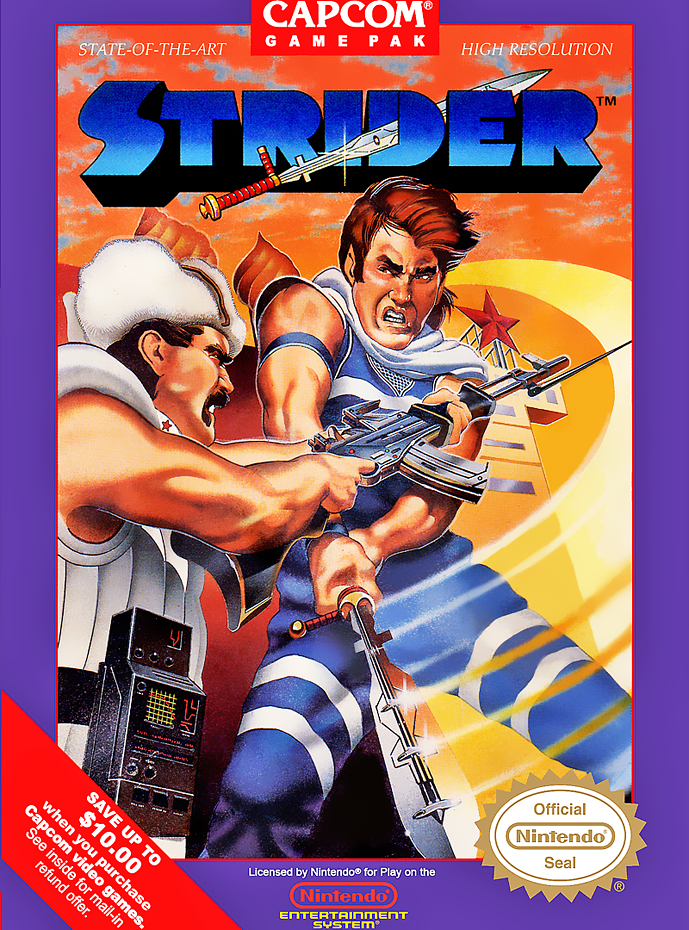Another Strider game beaten! After the disappointment that was Strider Returns, I decided to play the follow-up to the arcade game made by Capcom themselves. No, not Strider 2…

And yes, that’s an NES game advertising “high resolution.” Make of that what you will.
Anyway, this is a platform game, but it plays much differently than its arcade counterpart. For one example, jumping is no longer fixed, meaning you can change direction while in mid-air, but you can’t make long forward jumps anymore. The jumping arc is also much quicker than in most platformers, making it difficult to make what would otherwise appear to be simple jumps. Another example is that you can’t climb on walls or ceilings anymore; instead, you have this incredibly finicky wall-jump technique that I never could quite get the hang of, so I can’t really describe it. What I can describe, however, is Strider’s new and awkward interaction with walls: whenever you hit a wall mid-jump, you immediately begin to fall down, even if you’re not at the apex of your jump (and even if the “wall” was just the side of a one-unit-tall platform). This is especially annoying when trying to make what would otherwise be really simple jumps: never mind that the platform is only two units above you, if you jump while right beside the platform, it registers you as hitting the wall, so you fall back down before you can make the jump. That’s not the only unintuitive control the game has, either. For example, not long into the game, you get the ability to slide. How do you perform the slide? Perhaps down and jump, like in the Mega Man games? Nope, it’s down and forward and jump. I had to look up a walkthrough just to figure out some of the game’s controls.
However, there are two major details that this game shares with its arcade counterpart: most bosses can be beaten in just a couple seconds and the last stage is quite a difficulty spike.
Moving on: something I’d like to give the game props for is its story. To be fair, it’s based on a manga, but it still has a much more in-depth story than most platformers of its day. Plus, when you get your password, it will have a “next time on” blurb, similar to Saturday morning cartoons. Not only is it a neat aesthetic along with being one of the first games to do something like it (take that, Alan Wake!), but it will even give you hints on where to go if you’re stuck, which is another neat touch.
Being an NES game, there aren’t that many levels and the levels aren’t that big, so the game does some things to lengthen its playtime. One of them is that, at certain points, you’ll have to go back to a previous level and use an item to reach a certain point that you weren’t able to reach before. I didn’t mind this since you get to explore new parts of the levels. Plus, the level select is similar to Metroid Prime 3: Corruption, so you won’t have to retrace your steps from other levels to get back to a previous one. However, the game also has one-way tunnels, and if you’re not careful, these will sometimes set you back in the level, which is quite annoying. Also, there are a couple parts that have enemies too small to attack while ducking, so you have to wait for them to get in range or go away.
One last thing I feel the need to mention is the (semi)final boss. Not only is he at the end of a relatively long stage filled with battles against previous bosses and mini-bosses (including a few you have to fight twice), but unlike all the other bosses, you can’t attack him with your cipher; he’ll just knock it out of your hands and charge you, and he takes away a lot of your health when he does so. I lost many lives to this guy before eventually looking up the walkthrough again (and whenever you die, you’re sent back to the title screen, so each level has to be beaten in one life). What you have to do to beat him is use the plasma weapon, but how do you do that? Well, it turns out that if you stand still and hold up for a few seconds (holding up is normally used to attack enemies above you), your cipher will glow, and then you can push the attack button to shoot a projectile. The boss will even stand in front of you and wait for you to finish charging, which, after dying so much against him, I found rather funny. When you shoot him with the plasma weapon, you knock his weapon away, and that’s when you can attack him (and, true to the nature of Strider games, he goes down in just a few seconds).
Overall, I can’t recommend this game. It has some fun parts, but the finickiness of the wall jumping mechanic combined with some unintuitive controls really take away from the experience.
THE NEXT STORY!
WILL I EVER GET AROUND TO PLAYING STRIDER 2, OR WILL I COME ACROSS ANOTHER STRIDER GAME THAT PREDATES IT?
COMING NEXT SCENE:
“ANOTHER RPG, ANOTHER LENGTHY ABSENCE”
This comment was deleted about 8 years ago.
I think Strider on PS1 was my only experience with the series, but I love your long reviews.
HYPE
Ha ha, thanks! In case you haven’t seen my most recent post, I’m postponing the RPG until my new computer arrives (my current one tends to overheat when running anything around PS2 quality), so I’ll have to revise that last part a bit:
THE NEXT STORY!
TIRING OF USING LITERAL ICE TO KEEP MY LAPTOP COOL, I DECIDE TO PLAY LESS DEMANDING GAMES FOR NOW.
COMING NEXT SCENE:
“HE’S A BREAKOUT WIZARD”
HYPE CONTINUES